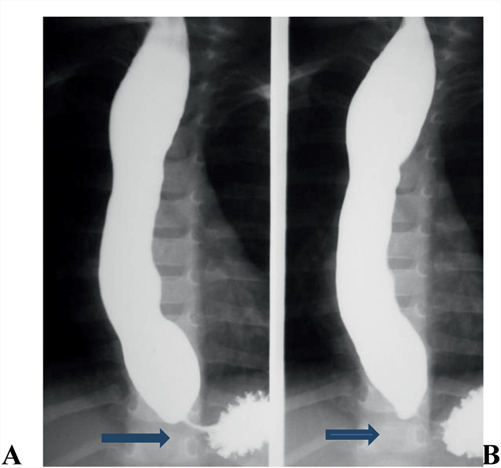Fig. 17.1
Barium swallow and meal showing the classic narrowing of the lower esophagus (bird’s beak sign)

Fig. 17.2
Barium swallow showing bird’s beak sign. Note also the dilated tortuous esophagus
Endoscopy is helpful in the diagnosis of achalasia although it can be normal in early stages of achalasia. Often, there is inflammation of the esophagus, which is caused by the irritating effect of food and fluids that collect in the esophagus.
Treatment
Achalasia is still not a curable disease and the goals of therapy are:
To relieve symptoms
To improve esophageal emptying
To prevent the development of megaesophagus
The following treatment options are available:
1.
Pharmacologic treatment :
A group of oral medications that help to relax the lower esophageal sphincter has been used to treat achalasia.
This includes drugs like nitrates (isosorbide dinitrate, Isordil) and calcium channel blockers (nifedipine, Procardia; verapamil, Calan; sildenafil, Viagra).
Although some patients with achalasia, particularly early in the disease, have improvement of symptoms with medications, most do not.
By themselves, oral medications are likely to provide only short-term relief of symptoms and many patients experience side effects (nausea, headache, low blood pressure). These are rarely used in children.
Because of this, the use of pharmacologic treatment is rather limited to the beginning of the disease and for patients who did not respond to interventional or surgical treatment.
2.
Pneumatic balloon dilatation of the lower esophageal sphincter:
The advantage of this is that no operation is needed as this can be done during endoscopy (Fig. 17.3).
Stay updated, free articles. Join our Telegram channel

Full access? Get Clinical Tree


